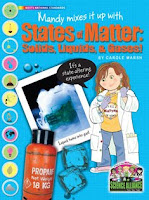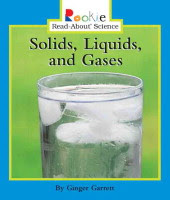Everything around you is made up of matter. Matter is defined as anything that has mass and takes up space. The three different states of matter are solids, liquids, and gases, and each state has its' own characteristics. Our senses are always helpful when distinguishing one state of matter from another. Though solids, liquids, and gases all have their own unique characteristics, some matter can change from one state to another. This post provides resources that, in addition to characterizing each state of matter, show the effect temperature has on the different states of matter.
While this post focuses on the states of matter at the 5th grade level, this topic also appears in the Virginia Standards of Learning for 2nd grade.
Books
While this post focuses on the states of matter at the 5th grade level, this topic also appears in the Virginia Standards of Learning for 2nd grade.
Books
Mandy Mixes It Up With States of Matter: Solids, Liquids, and Gases. By Carol Marsh. 2008. 32p. Ga llopade Intl., (9780635066688). Gr. 4-6.
llopade Intl., (9780635066688). Gr. 4-6.
This activity book is written from the perspective of a group of kids who call themselves the "Science Alliance. This advanced book presents definitions and explanations for the three states of matter, as well as various activities students can complete.

 llopade Intl., (9780635066688). Gr. 4-6.
llopade Intl., (9780635066688). Gr. 4-6. This activity book is written from the perspective of a group of kids who call themselves the "Science Alliance. This advanced book presents definitions and explanations for the three states of matter, as well as various activities students can complete.

Solids, Liquids, and Gases . By Ginger Garrett, Linda Bullock. 2005. 32p. Scholastic Library Publishing, (9780516246635). Gr 2-6.
This simple and direct text uses water, a candle, and the human body to illustrate the three different phases of matter.
States of Matter: A Question and Answer Book. By Fiona Bayrock. Illus. by Anne McMullen, Ted Williams. 2007. 32p. Capstone Press, (9781429602273). Gr. 3-6.
This picture book introduces the composition of matter, the different states, and the effects of changing states.
This simple and direct text uses water, a candle, and the human body to illustrate the three different phases of matter.
States of Matter: A Question and Answer Book. By Fiona Bayrock. Illus. by Anne McMullen, Ted Williams. 2007. 32p. Capstone Press, (9781429602273). Gr. 3-6.
This picture book introduces the composition of matter, the different states, and the effects of changing states.
What Is the World Made Of? All About Solids, Liquids, and Gases. By Kathleen Weidner Zoehfeld. Illus. by Paul Meisel. 1998. 32p. Harper Collins Publishers, (9780064451635). Gr. 2-5.
"Walls and blocks, dolls and socks. Milk and lemonade. Rocks and tress. All of these things are made of matter" (6). Water is matter that can easily change its state depending on the temperature; but most matter stays as one state.
"Walls and blocks, dolls and socks. Milk and lemonade. Rocks and tress. All of these things are made of matter" (6). Water is matter that can easily change its state depending on the temperature; but most matter stays as one state.
What's the Matter in Mr. Whiskers' Room? . By Michael Elsohn Ross. Illus. by Paul Meisel. 2007. 48p. Candlewick Press, (9780763635664). Gr. 2-5.
When Mr. Whiskers prepares to teach his science class about matter, he sets up various learning stations in the classroom and on the playground. Mr. Whiskers' students get to travel around to each station and experiment with the different forms of matter. Directions for setting up each learning station are included in the book.
When Mr. Whiskers prepares to teach his science class about matter, he sets up various learning stations in the classroom and on the playground. Mr. Whiskers' students get to travel around to each station and experiment with the different forms of matter. Directions for setting up each learning station are included in the book.
Web Sites
This site gives characteristics of each state of matter, as well as a description and explanation of particle movement in solids, liquids, and gases.
Information for Properties of, and Changes in, Matter
At this site, teachers can gain background information on matter, get ideas from provided lesson plans and student activities. This site includes additional resources and websites for teachers who seek to better their understanding of, and ability to teach, matter.
Information for Properties of, and Changes in, Matter
At this site, teachers can gain background information on matter, get ideas from provided lesson plans and student activities. This site includes additional resources and websites for teachers who seek to better their understanding of, and ability to teach, matter.
This game will allow students to categorize words and phrases in relation to each state of matter. Students will learn how to associate different vocabulary with the different states.
This web site includes an interactive video about solids, liquids, and gases, as well as the effects of temperature on the states. Also on this site is a song about the states of matter and the changes that can occur from one state to another. In addition, provided is a short vocabulary list of words to consider when thinking about the states of matter. Lastly, the site contains a short quiz that covers the states of matter.
Teaching Matter
This site contains several lesson plan ideas from various teachers who have taught matter at various grade levels.
Teaching Matter
This site contains several lesson plan ideas from various teachers who have taught matter at various grade levels.
For Teachers
Virginia Science Standards of Learning
5.4 The student will investigate and understand that matter is anything that has mass and takes pus space; and occurs as a solid, liquid, or gas. Key concepts include
a) distinguishing properties of each phase of matter;
b) the effect of temperature on the phases of matter
Background Information from Curriculum Framework
Grade 2
Background Information from Curriculum Framework
Grade 2
- Matter is anything that has mass and takes up space.
- Matter comes in three different forms: solids, liquids, and gases. Solids hold their shape, liquids and gases have no shape.
- Some matter can change its state with the presence of more energy and vice versa.
- Particles in a solid are bonded tightly together, and usually have a specific pattern. These particles do vibrate, but do not move from place to place.
- Particles in a liquid are close together, but have no particular arrangement. Liquid particles vibrate and slide past one another.
- Particles in a gas are well separated with no regular arrangement. These particles move freely and rapidly throughout.
- A rise in temperature can cause a solid to melt and turn into a liquid, and cause a liquid to turn into a gas.
- A decrease in temperature can cause a liquid to turn into a solid.


No comments:
Post a Comment